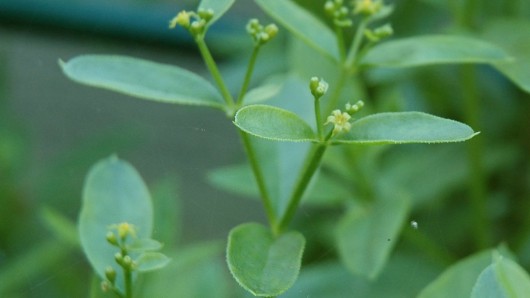Plant root used to create eco-friendly lithium-ion battery
By Darren Quick
December 11, 2012

Researchers have used a dye extracted from the root of the madder plant to develop a new 'green' lithium ion battery (Photo: Carstor via Wikimedia Commons)
Researchers have found an eco-friendly alternative to the metal ores
currently favored in the electrodes of lithium-ion batteries. The
new non-toxic and sustainable battery uses purpurin, a red/yellow
dye extracted from the root of the madder plant that has been used
for dying cloth for at least 3,500 years – meaning the substance can
simply be grown rather than mined.
Currently, lithium cobalt oxide (LiCoO2) is the material of choice for forming the cathode in Li-ion batteries. However, mining the cobalt and combining it with lithium at high temperatures to form the cathode is an expensive and energy-intensive process.
Couple this with the energy used to extract the cobalt at the recycling stage and Dr. Arava Leela Mohana Reddy from Rice University says that for every kilowatt-hour of energy in a Li-ion battery, production and recycling pumps an estimated 72 kg (159 lb) of carbon dioxide into the atmosphere.
Dr. Reddy, along with Rice University colleagues and researchers from The City College of New York and the U.S. Army Research Laboratory, found that purpurin and other biologically based color molecules offer great potential as a more environmentally friendly alternative. This is due to the carbonyl and hydroxyl groups in the molecules that are adept at passing electrons back and forth.
“These aromatic systems are electron-rich molecules that easily coordinate with lithium,” explained City College Professor of Chemistry, George John.
Making the purpurin electrode can be done at room temperature in a simple process which involves dissolving the purpurin in an alcohol solvent and adding lithium salt. After the solution turns from reddish yellow to pink, indicating the salt’s lithium ions have bonded with the purpurin, the solvent can be removed and the electrode is ready.
The team claims the purpurin is less complicated to use than the one or two other organic molecules being examined for use in batteries. Additionally, growing madder or other biomass crops would help remove carbon dioxide from the atmosphere. The resulting batteries would also be non-toxic, making them easier to dispose of.
Using purpurin, with 20 percent carbon added to improve conductivity, the research team built a half-battery cell with a capacity of 90 milliamp hours per gram after 50 charge/discharge cycles.
The researchers are confident their green Li-ion battery will be commercially produced in the next few years. This takes into account the time needed to improve purpurin’s efficiency or find and synthesize similar molecules.
“We can say it is definitely going to happen, and sometime soon, because in this case we are fully aware of the mechanism,” said Professor John.
The team’s research appears in Nature’s online and open access publication, Scientific Reports.
Source: City College of New York, Rice University
Copyright © gizmag 2003 - 2012 To subscribe or visit go to: http://www.gizmag.com
